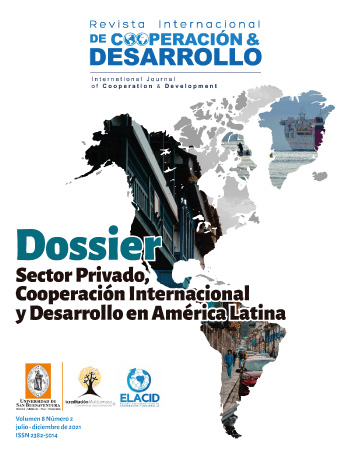INTERNATIONAL JOURNAL OF COOPERATION AND DEVELOPMENT
Assignment of Rights
Authorization for reproduction, publication, communication and distribution of a literary, artistic or scientific
Work.
I , ____________________________________________, author of the book and / or article , of legal age , resident of the city of _________________ , identified with citizenship / passport n° ______________________ issued on _______________________, in exercise of his physical and mental faculties , part henceforth be called the AUTHOR , supports the following authorization to the reproduction, publication, communication and distribution of a work, perform the following terms:
1. Regardless of current legal regulations due to the linking of the parties to this contract, and any kind of legal presumption , the parties agree that the AUTHOR authorize ( name of the publisher ) to reproduce , publish , communicate and distribute the material referred to in the International Journal of Cooperation and Development of the University of San Buenaventura.
2. Such authorization lies in particular on the copyright of the work, by any means known or unknown, publication of the work, distribution of the work , either directly or through third parties for purely educational purposes.
3. AUTHOR agrees to report and declare the existence of this authorization and to preserve the right of the International Journal of Cooperation and Development of the first publication of the work.
4. AUTHOR declares that the article is original and that it is his sole creation, no impediment of any kind exist for the authorization he is doing, besides being responsible for any action claim, plagiarism or other type of claim that might arise about .
5. Such permission is free of charge.
6. Moral copyright in the article are solely the AUTHOR and the University of San Buenaventura expressly agrees to recognize and respect them rigorously.
The Author and / or AUTHORS
SIGNATURE
Abstract
Trafficking in persons is an international crime that is increasingly relevant in the national and international agenda. Achieving its total eradication has become one of the sustainable development goal targets, but reaching this objective demands a social agreement about its prosecution, otherwise, organized crime and criminal networks will strengthen within vulnerable environments where there is a lack of actions to punish this kind of crime. Those environments exist and there are people who even think it is normal when someone falls under the desires or orders of certain others. One of the most affected populations for this conduct is the indigenous community, where their people are not only kidnapped, trafficked, or sold, but they could also be the victimizers under the protection of their own manners or ancestral traditions. Despite the recognized independence of the indigenous jurisdiction, the violation of human dignity requires to create channels of communication with the ordinary jurisdiction aimed at preventing this crime from spreading further.
This article presents a collection of principles that close gaps between the special indigenous jurisdiction and the ordinary one. Consultation of this collection makes it possible to fight against this crime regardless of the jurisdiction it has been committed. It is expected that this article contributes to avoiding that cases on trafficking persons, with the participation of an indigenous actor, will remain to the justice silence. This principles collection can be consulted as a tool to facilitate the inter-jurisdictional dialogue in order to rescue the human dignity in every society
Keywords: indigenous jurisdiction, crime, trafficking human, communities, indigenous people
This article presents a collection of principles that close gaps between the special indigenous jurisdiction and the ordinary one. Consultation of this collection makes it possible to fight against this crime regardless of the jurisdiction it has been committed. It is expected that this article contributes to avoiding that cases on trafficking persons, with the participation of an indigenous actor, will remain to the justice silence. This principles collection can be consulted as a tool to facilitate the inter-jurisdictional dialogue in order to rescue the human dignity in every society.
References
Arrieta Burgos, E. (2019). Derechos sociales y proporcionalidad: aproximaciones conceptuales y metodológicas a partir de la jurisprudencia constitucional colombiana. En, A. Sánchez Bravo, L. de Casimiro, E. Gabardo (Eds.). Estado social y derechos fundamentales en tiempos de retroceso. (pp. 131-158), Punto rojo libros. https://repository.upb.edu.co/bitstream/handle/20.500.11912/4947/Derechos %20sociales%20y%20proporcionalidad....pdf?sequence=1
Arroyo Zapatero, L. (2009). De la lucha contra la esclavitud y la trata de blancas a la proscripción del tráfico de seres humanos. En, Delmas-Marty, M., Pieth, M. & Sieber, U. Los caminos de la armonización penal, Editorial Tirant lo Blanch. (pp.129-154). Morales, M. (Coord). Valencia: Tirant lo blach, Universidad de Castilla La Mancha, nTeoría.
Becerra Becerra, C. A. (2006). La JEI y el derecho penal en Colombia.
Boldova Pasamar, M. A. (2010). Trata de seres humanos, en especial menores. Revista de Derecho Migratorio y Extranjería. 23. 51-112.
COAT, Centro Operativo Anti-Trata. (2022). Eje de protección y asistencia a las víctimas. Mininterior. de https://tratadepersonas.mininterior.gov.co/estrategia/eje-de-proteccion-y-asistencia-las-victimas
Congreso de la República de Colombia, Oficina Asesora Legislativa. (2004). Estudio de antecedentes sobre Jurisdicción Especial Indígena concluido el 9 de julio de 2004. Mentor a cargo, Álvaro Forero Navas. https://www.camara.gov.co/sites/default/files /2017-11/022%20Jurisdiccion%20Especial%20Indigena.pdf Consultado el 2 de julio de 2004.
Congreso de la República de Colombia. (26 de agosto de 2005). Ley 985 de 2005 por medio de la cual se adoptan medidas contra la trata de personas y normas para la atención y protección de las víctimas de la misma. Diario Oficial No. 46.015 de 29 de agosto de 2005
Constitución Política de Colombia. (1994). Constitución Política de Colombia de 1991. Bogotá: Ediciones Emfasar.
Corte Constitucional. (1996). Sentencia C-139/96. (Carlos Gaviria Díaz, M. P.).
Corte Constitucional. (1998). Sentencia SU-510/98. (Eduardo Cifuentes Muñoz, M.P.).
Corte Constitucional. (2013). Sentencia T-921/13. (Jorge Ignacio Pretelt Chaljub, M.P.)
Cruz Micán, D. (2016). Jurisdicción Especial Indígena en Colombia. Universidad Católica de Colombia. https://repository.ucatolica.edu.co/bitstream/10983/14158/1/De%20la%20Jurisdicci%C3%B3n%20especial%20ind%C3%ADgena%20en%20Colombia.pdf
Departamento Administrativo Nacional de Estadistica -DANE-, 2019. Población Indígena de Colombia. Resultados del Censo Nacional de Población y Vivienda 2018. (Formato presentación en pdf).
Fernández Hernández, J. J. (2019). La regulación de la trata de seres humanos: esclavitud del siglo XXI. Revista de Estudios en Seguridad Internacional, 5(1), 153-172. http://www.seguridadinternacional.es/resi/index.php/revista/article /view/119/208
Fundación Keralty, Oficina de prensa. (2021). Proyecto "A Guajira" continúa fortaleciendo la salud de la comunidad Wayúu. https://www.keralty.com/es/web/guest/proyecto-de-fundacion-keralty-comunidad-wayuu#:~:text=Bogot%C3%A1%2C%20mayo%20de%202021.,promuevan%20redes%20comunitarias%20de%20cuidado.
Gros, Cristian. (1993). Derechos indígenas y nueva Constitución en Colombia. Revista Análisis Político. 19. Instituto de Estudios Políticos y Relaciones Internacionales. Universidad Nacional de Colombia. Bogotá.
Oficina de las Naciones Unidas contra la Droga y el Delito (UNODC). (2021). UNODC y la agenda 2030 para un desarrollo sostenible. https://www.unodc.org/mexicoandcentralamerica/es/romex/UNODCyAgenda2030.html
Organización de las Naciones Unidas. (1948). Declaración Universal de los Derechos Humanos de 1948. https://www.un.org/es/about-us/universal-declaration-of-human-rights Consultada el 09 de noviembre de 2021.
Organización de las Naciones Unidas. (1949). Asamblea General. Convenio para la Represión de la Trata de Personas y de la Explotación de la Prostitución Ajena.
Organización de las Naciones Unidas. (2010). Convención de las Naciones Unidas contra la Delincuencia Organizada Transnacional.
Organización de las Naciones Unidas. (2010). Convención para la Erradicación de la Trata de Personas. Protocolo para Prevenir, Reprimir y Sancionar la Trata de Personas, especialmente mujeres y niños, también conocido como el Protocolo de Palermo (2000).
Organización de las Naciones Unidas. (2019). Informe de los Objetivos de Desarrollo Sostenible. ONU. https://unstats.un.org/sdgs/report/2019/The-Sustainable-Development-Goals-Report-2019_Spanish.pdf
Organización de las Naciones Unidas. (2021). Declaración Universal de los Derechos Humanos. Historia de la Declaración. https://www.un.org/es/about-us/udhr/history-of-the-declaration
Salas, C. (2015). Reclutamiento ilegal de menores y patrimonio cultural inmaterial: El caso de las comunidades indígenas en Colombia. Boletín OPCA, 09, 58-66. https://opca.uniandes.edu.co/reclutamiento-ilegal-de-menores-y-patrimonio-cultural-inmaterial-el-caso-de-las-comunidades-indigenas-en-colombia/
Perafán Simmonds, C. C. (1995). Sistemas Jurídicos Paez, Kogi, Wayuu y Tulè. Bogotá, Colcultura.
Pineda Camacho, R. (2002). Estado y Pueblos indígenas en el siglo XX. La política indigenista entre 1886 y 1991. Bogotá.
Sánchez Botero, E. (2005). Reflexiones en torno de la jurisdicción especial indígena en Colombia. Revista IIDH, 41, 225-251. https://www.corteidh.or.cr/tablas/r08062-9.pdf Consultado el 2 de julio de 2021.
Sánchez Botero, E. & Jaramillo Sierra, I. C.,(2007). La jurisdicción especial indígena. Instituto de Estudios del Ministerio Público (IEMP) de la Procuraduría General de la Nación. Bogotá: Imprenta Nacional.
















